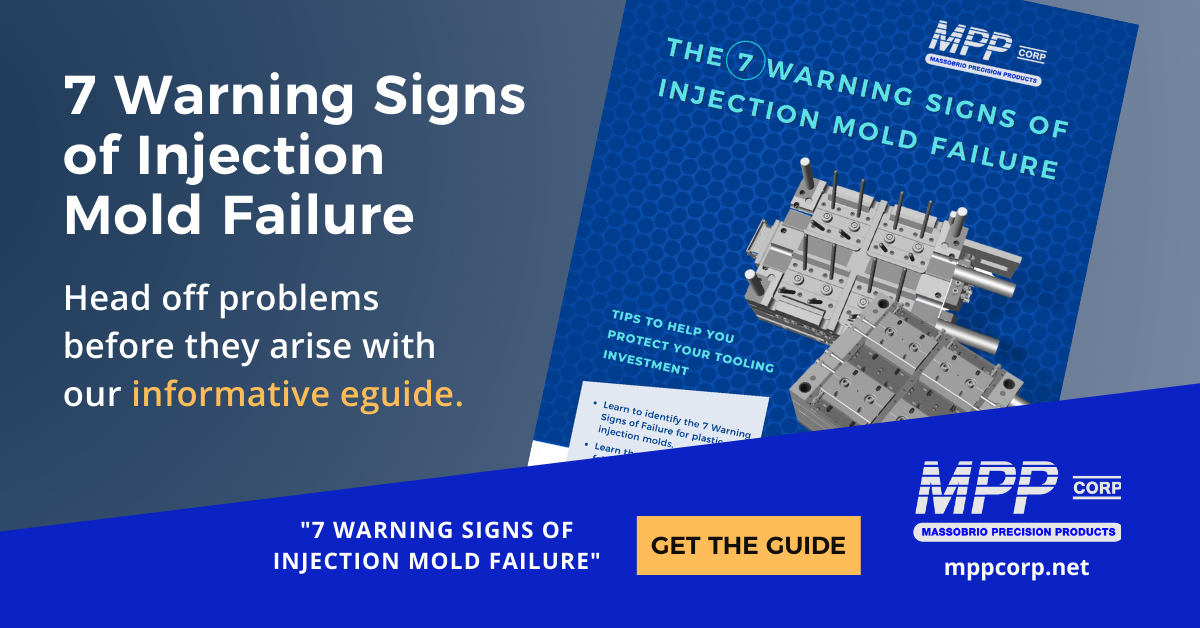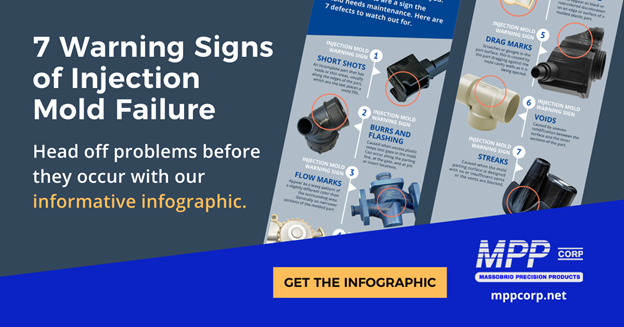You spend a lot of money on your plastic injection molds. Maintaining and repairing them can keep them running for years, providing a valuable return on your investment.
Short of a mold totally crashing, how do you know when a mold needs repair or maintenance? This article will tell you. We identify plastic part defects that can be signs of mold repair and maintenance. This article is part of a series discussing injection mold maintenance and repair.
Signs That Your Injection Mold Needs Repair or Maintenance
How do you know when a mold needs maintenance or repair? Short of a complete failure, here are the 7 tell-tale signs to look for in the parts that are produced by the mold.
- #1: Short shots where parts are ejected in an incomplete state
- #2: Burrs and flashing caused when excess plastic seeps into gaps in the mold
- #3: Flow marks caused by uneven injection speed or cooling
- #4: Blistering, stress cracks, and burn marks brought on by prolonged exposure to high temperatures
- #5: Drag marks caused by a misaligned ejector system
- #6: Voids or depressions from non-uniform heating or cooling of materials
- #7: Streaks
I this article, we discuss warning sign #2, Burrs and Flashing.
Injection Mold Warning Sign #2: Burrs and Flashing
 seeps into gaps in the mold. These can occur in multiple locations, including along the parting line, at the gate, and at pin or insert locations. This defect appears as a thin lip or protrusion of excess plastic along the edge of a part.
seeps into gaps in the mold. These can occur in multiple locations, including along the parting line, at the gate, and at pin or insert locations. This defect appears as a thin lip or protrusion of excess plastic along the edge of a part.
Flash appears because material has flowed outside of the intended flow channels and into the space between the tooling plates or at the injector pin. When plastic is injected into a mold, it’s under a significant amount of pressure. Under ideal circumstances, when the plastic enters the mold, it fills the mold (the first stage of plastic injection) and is then held there at pressure (the second stage, pack/hold). However, this pressurized molten plastic may attempt to push out of the mold between the two parts of the mold or between mold plate surfaces or at injector pin sites.
Flash is undesirable because parts may need to be reworked to trim the excess material, resulting in extra work time.
There are several root causes for flash on a part. These include:
- Mold Wear Issues: The most common issue that causes flashing is a worn or old mold that no longer fits tightly together
- Mold Design Issues: A mold may also just be poorly designed, either with gaps that cause flashing or pressure issues due to multiple parts or overly complex geometries that cause poor fits
- Pressure and Flow Issues: Flash can be an indicator of pressure or temperature issues in the mold. Redesigning the mold with better gates or hot runners can assist in dealing with the issue
- Mold Clamping: Lastly, the issue could be that the plates are not clamped with sufficient force to avoid resin forcing its way between plates. Increasing the plate clamping force or moving the mold to a machine with higher clamping force can solve this issue
Choose an Injection Mold Maintenance and Repair Partner You Can Trust
Why choose MPP? When you choose MPP, you get:
- A team of mold builders who have a combined 100+ years of mold building experience
- Expert knowledge of plastics and manufacturing processes
- In-house engineering and design services from experienced engineers
- In-house repair and maintenance from skilled mold builders, welders and machine operators
- A Quality Assurance system that meets all requirements of the ISO 9001:2008 Quality Assurance Standard
- Pickup and delivery from anywhere, anytime
- Personalized solutions
To discover how we can help you, call 810.364.2939 or contact us.



